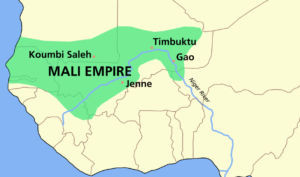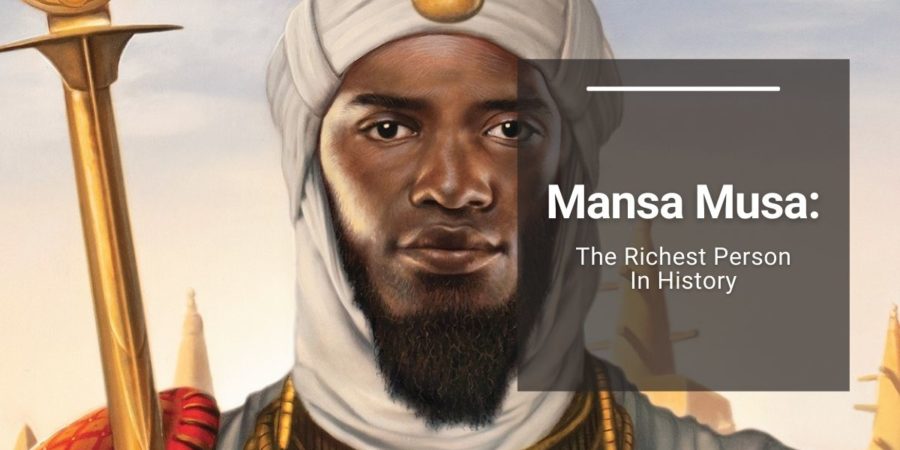Mansa Musa: The Richest Person In History | The How To Take Over The World Podcast
“Mansa Musa was a person who really had so much wealth that the only thing he didn’t have were things he didn’t want to have.”
Mansa Musa is the article of many legends.
But it’s the facts about him that are the most fascinating. For instance, he’s the only person in recorded human history to possess limitless wealth.
Adjusted for inflation he was wealthier than Tesla’s Elon Musk and Amazon’s Jeff Bezos combined almost 700 years ago. The only other person who comes close is standard oils, John D Rockefeller ($340B) who’s company at it’s peak produced 2% of Americas GDP.
What if anything can we learn from Mansa Musa.
The Empire of Mali
The empire he presided over, Mali was, founded in the year 1235 in Western Africa by Sundiata Keita, nicknamed the Lion of Mali.
We know little about Keita other than that he was a prince warrior who led the battle to free the Mali people from the rule of the ancient Ghanaian empire.
He later expanded Mali’s territory, securing trans-Saharan trade routes, connecting sub-Saharan Africa to the rest of the world.
By the time Mansa Musa took over, which we’ll get to shortly. The Mali empire covered 50,000 square miles of West Africa, extending from the Sahara all the way to the Coast.

The three big commodities at the time (gold, copper, and salt), were all abundant. In particular, there were three massive gold mines that still operate and drive Mali’s economy today.
The Story of Mansa Musa’s Predecessor, Mansa Abu Bakr II
Mansa Abu Bakr II was not interested in the affairs of his empire and West Africa. Instead, he wanted to find new lands. He believed that just like a river, the ocean had boundaries – A contrarian view at the time.
So, Abu Bakr equipped 200 boats full of men, gold, water, and everything else they needed, to sustain them for several years and ordered the chief admiral to not return until they found the ‘other side’.
After a long period of absence, only one boat returned. On questioning, they said;
“Prince, we have navigated for a long time, until we saw in the midst of the ocean as if a big river was flowing violently. My boat was the last one; others were ahead of me. As soon as any of them reached this place, it drowned in the whirlpool and never came out. I sailed backward to escape”
Mansa Abu Bakr II did not believe the captain and decided he needed to go himself. This time with 2000+ boats equipped with everything needed for him and his men he set off to discover new worlds.
The man he left in charge to reign in his absence was Musa I.
Some theories suggest Abu Bakr II reached the Americas. Some reports state people of the Caribbean Islands wrote legends of black men from the south who carried massive amounts of copper and gold.
Academics say there is no evidence to suggest these conspiracies are true as not a single African artifact from this time has been found.
Mansa Musa’s Reign
After not returning for more than a year Mansa (meaning king) Musa (Musa I) became the 9th emperor of Mali.
With over 100,000 soldiers and 10,000 horses at his disposal, Mansa Musa greatly expanded his empire. He wrestled control of key cities such as Timbuktu and Gao, which were rich in salt and gold and gave him control of some of the most important trade routes in the region. By the end of his reign, he had doubled the size of his empire, making it the second-largest in the world, only behind the Mongols.
Also unique for his time, he managed to lead an extremely diverse empire with people of all different backgrounds, cultural, and religious beliefs. As a devout Muslim, he wanted to impose Islamic rule. But after listening to his people, settled with a progressive religious tolerance.
Mansa Musa Makes His Hajj One to Be Remembered for Years
“We all need good habits, to have big goals that we slowly work towards over time. But in addition, you should think about what your Hajj would be. What can you do to make yourself unforgettable?” – Ben Wilson
The Hajj is a trip to the holy city of Mecca that every Muslim is expected to make at least once in their life. When Mansa decided it was time for his Hajj, he wanted to make it in a spectacle.
He was accompanied by 60,000 people, all wearing expensive silk, with gold embroidery, from royal officials to soldiers and entertainers, to slaves. The men on horses waved gold banners, and gold flowed from the caravans as they walked through the cities, handing it out to many thousands.
It is said that the gifts and donations received from his travelling circus were enough to feed people for 10 years.
“The entourage ended up giving so much gold and spending so much in the market that the value of gold in Cairo crashed by 20%”
It took over a decade for the price of gold to recover from the massive depreciation and caused north of a billion dollars in economic loss. That equates to roughly ¼ of a trillion today.
Inspired by the Journey
Mansa Musa was impressed by the universities, architecture, schools, and libraries of Cairo. When he returned home, he devoted much of his time to make his empire a centre of learning. He picked up scholars and architects from all over the middle east and brought them back to the city of Timbuktu.
Musa made the city so famous that even as late as the 1800s, Europeans were still venturing through the inhospitable desert of Sahara to find it. The city turned into an educational hub as people travelled from around the world to study at what is now known as the Sankore University.
Our Takeaway Menu
So what’re the takeaways here?
For 700 years now a few of these rules still apply.
- The best marketing is not scalable. Musa used his Haji as an excuse to make himself and his empire famous. The fact we’re still talking about it today is proof enough that it worked.
Richard Branson & Steve Jobs are two modern stories of marketing via the unscalable.
Movies are another. The star wars franchise grossed $10 billion in movie receipts and another $70 billion in merchandise and licensing sales.
- If legacy is what you seek, then a strong vision for your legacy is what you need. The Haji made Musa famous but the vision for his empire he crafted while on his travels is what his people worshipped and remembered him for.
Still to this day, Timbuktu may be one of the worlds most famous cities and yet receives no media attention and has little cultural significance in western culture. His vision and legacy lives on, through, that he formed and built for Timbuktu has survived 7 centuries.
- If you want to be remembered either for eternity or for the next time you meet someone. You need todo one thing that is unforgettable.
1000’s of micro forgettable moments are not enough. You’ll soon enough be forgotten. Musa’s way of being unforgettable is not accessible for us, however there are many ways you can create one unforgettable moment with each impression.
First of all, you just need to be a little different. That could be a fist bump instead of a handshake. A compliment instead of discussing the weather.

One comment
Pingbacks and Tracebacks
[…] Thanks to Mansa Musa and my Dad, Timbuktu was the most recited city of my childhood. I still don’t know why but any question resembling ‘how long will it take to get there was always met with a rhetorical ‘how long till Timbuktu? For 700 years, Timbuktu has been an oddly famous city. It receives relatively little media attention, hasn’t gone viral on Tiktok or featured in a Drake song. Yet, thanks to a religious pilgrimage circa 1300bc, it might forever be a place the world over knows of but little about. Why? Mansa (King) Musa did something we part-time, and full-time wanna-be marketers can learn from. The most impactful and lasting marketing activities are not scalable. You can run Facebook ads until Donald Trump becomes president again, but you’ll still be nothing more than a glitch in most people’s minds. Mansa Musa, like every committed Muslim, carried out his duty of Haji with a twist. Rather than being a memorable moment for himself, he made the occasion unforgettable for everyone else. He was accompanied by 60,000 people, from royal officials to soldiers and slaves. All draped in silk with gold embroidery. Mansa made his Haji a spectacle. Gold flowed from his caravans as they waved their gold banners walking through the cities. Legend has It the gifts and donations received from his travelling circus were enough to feed people for ten years. His entourage spent and donated so much gold that the market value in Cairo crashed by 20%. Causing $250 billion+ in economic loss (adjusted for inflation) and required a ten-year recovery. Many ultra-wealthy people have been and gone, but none are more memorable or legend-able than Mansa Musa. Macro unscalable – not cheap & repeatable, is how you become memorable and create a lasting legacy. You can look to Conor Mcgregor, Logan Paul or Richard Branson for modern-day examples or read about the rest of Musa’s story here. […]